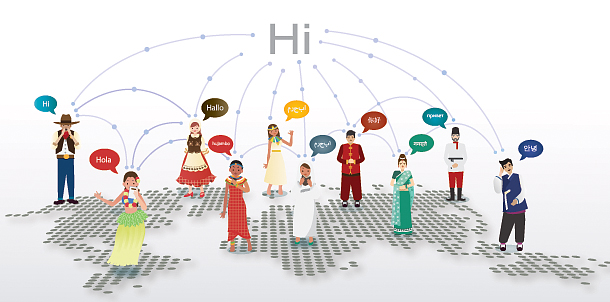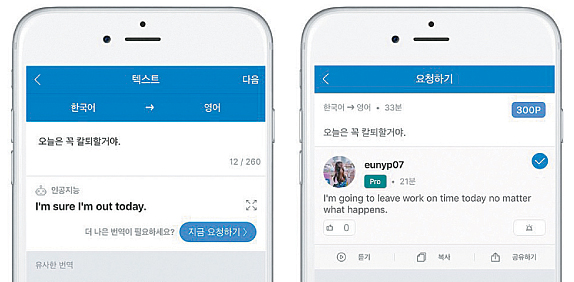[Korea and the fourth industrial revolution <13-1 Translation>] Lost in translation? Ask a machine

[ILLUSTRATED BY BAE MIN-HO]
“The translation is important,” the director emphasizes to the translator whilst giving him a lengthy set of directives to convey to Harris, but it’s not long before the Japanese interlocutor bungles the job.
“He wants you to turn, look in camera. OK?” the translator tells Harris. “Is that all he said?” Harris responds incredulously.
It’s been about 14 years since the film was released, and while one might imagine an interaction like the conversation between Harris and his Japanese colleagues happening today, the contemporary globetrotter has the added aid of translation apps that can clear up any misunderstandings.
Online translators, once thought to never be able to replace their human counterparts, are getting smarter by the day, and the business models are becoming more innovative, too.
One example is Flitto, a Korean translation app that supplements the work of its algorithm with tweaks from human editors. It offers automatic translation in 18 languages including Chinese, English and Korean, but if users are unsatisfied with the computer-generated translation, they can pay to get a revision from one of a million language experts that Flitto has approved to edit translations.
“Imagine you’re translating a sentence to a language you don’t have much knowledge of,” said Simon Lee, the chief executive officer of Flitto. “You have no options if you are not satisfied with the translated version when you use popular machine translation platforms. This is why we have decided to get help from actual human translators and experts to give satisfying results to our users.”
The response from a human translator, which Flitto requires to either have a translation license or pass one of its tests, can come in just minutes. Whenever a user requests a better translation, the app sends a message to all translators who are versed in the language. The translators submit their revisions, the user selects the best one and the translator who wins gets paid for the work with in-app points that can be converted to money. This crowdsourcing of translations benefits the individual user, but it also makes the algorithm smarter because it improves by analyzing a large pool of translations.
“AI works like a human brain - an algorithm needs to study to become smarter,” Lee said. “That is why I have decided to focus on both machine and human translations. We continue to update human translation results on the system so that the AI can study them and avoid making the same mistakes.”

On the left, Flitto’s algorithm produces an automatic translation. If users are not satisfied with the result, they can request a human editor to improve the translation, as shown on right. [FLITTO]
Flitto’s annual sales have reached around 10 billion won, but a majority of profit has come from selling its data to other machine translation service providers, not from users buying in-app points.
Many translation apps like Flitto use a technology called neural machine translation that corroborates millions of translations to produce results that sound more natural to the human ear. The technology has come a long way from earlier translation tools that depended heavily on human-programmed rules.
Kim Young-gil, a senior researcher at the Electronics and Telecommunications Research Institute, a government-funded think tank, envisions a future where translation technology will be so advanced that it can offer near instantaneous interpretation and remove any barriers to communication between people.
“I believe wearables like earpieces that offer translation services will become popularized in 10 years,” he said. “Many of the inconveniences that people face when using current machine translation platforms will disappear.”
From computers to earpieces
The history of machine translation goes back to 1950s, when the United States in the midst of the Cold War was trying to translate Russian documents into English. Computers back then were a lot slower, and machine translation didn’t draw as much public attention because it took more time and money compared to human translators.
The technology developed significantly after IBM introduced statistical machine translation technology (SMT) in 1988. Before SMT, the dominant technology was based on following grammatical rules, and the machines required human linguists to help with each translation. SMT was the first stab at using big data to help with translation, by collecting previous translations and offering results based on statistical frequency.
Google used the technology in its first translation service in 2006 for four languages: English, French, German and Spanish. Now, Google’s tool can translate nearly 100 languages and is used by more than 500 million people a month, according to a company spokesperson. It also employs a more advanced technology, the successor to statistical machine translation known as neural machine translation (NMT), that produces more accurate results.
The advent of NMT has spurred other tech companies like Microsoft and Naver to jump into translation, and there’s great potential. The market size for automated translation, which was $2.5 billion last year, is expected to grow 30 percent annually to $7 billion by 2019, according to the Translation Automation User Society, a Netherlands-based research center.
Naver, operator of Korea’s most popular search engine, released a translation app called Papago last year and is signing partnerships with Hyundai Department Store and GS Retail to install the translation service on their shopping sites.
The next logical step for the industry is wearable technology like earpieces. Hancom, a Korean office software developer, unveiled an earpiece earlier this year that lets speakers of different languages talk to each other based on the company’s translation software Genie Talk. The device has been designated as the official translator for next year’s Winter Olympics in Pyeongchang. “The software will be developed more from now on, and it will even understand dialects within three years,” said Shin So-woo, president of Hancom Interfree.
Hancom is not the first company to develop an earpiece for instantaneous machine translation. Similar devices have been released on the market, but many users have found them unreliable. The most recent start-up to attempt a translation earpiece is Australia’s Lingmo, which started selling a $179 earpiece this month.
The company says the device can translate sentences in less than five seconds using IBM’s AI system Watson. It aims to translate between Brazilian Portuguese, Chinese, English, French, German, Italian and Spanish, and it will be the first earpiece of its kind to do so without connection to a mobile phone or Wi-Fi network.
The Korean government is also investing heavily in machine translation. The Ministry of Science, ICT and Future Planning is spending 21.1 billion won this year to develop an AI-based system that can translate old historical records that were written in traditional Chinese into modern Korean.
The largest undertaking involves translating the Seungjeongwon Ilgi, a series of royal records written between 1623 and 1910 that documented the king’s day. Translation of the archive’s 3,243 books began in 1994 and was initially scheduled to end in 2062, but with the help of machine translation and human post-editors, the government expects completion by 2035.
The ministry also pledged additional spending of 163 billion won this year to develop AI technologies in general. The figure represents a 47 percent increase from last year, and the research projects will focus on high-demand software like language and voice recognition.
A long way to Babel
Despite the proliferation of advanced translation software, experts don’t see machines completely replacing humans in the near future.
“Translation requires decision making, choosing between a word-for-word translation and a liberal translation, and this requires human creativity,” said Seo Jeong-mok, a professor of translation studies at Daegu Catholic University. “This is why I believe translating perfectly by machine still has a long way to go.
“But the day will come since many technologies that humans have dreamt of in the past have already come to fruition,” he said. “Language barriers will disappear in the future, but paradoxically, we will be living in a society where we miss humans.”
Kim Jae-min, who runs a private academy that teaches English, said he doesn’t believe the technological developments will directly impact the education industry.
“We still learn math even though we have calculators,” he said. “I do agree that the technologies will allow us to use various languages more easily, but language itself is something that humans materialize. I don’t think machines will replace humans completely, since language is not just a set of words but has various things like emotion, culture and ways of expression.”
Simon Lee of Flitto believes the world will continue to need human translators.
“New words are introduced, and some words disappear, so I don’t think translating perfectly with machines will be possible without human help,” he said. “Just like robots and computers at hospitals, there are concerns about them making mistakes, and translation is the same thing.”
Lee is optimistic that translation technology will not threaten the jobs of human translators but help people expand their worldview.
“In Korea, for example, not many people read articles or books published in rich countries like France due to language issues,” he said, “but the technologies will allow people to at least have a glimpse of what they do, and they will be able to enjoy more various cultures that they couldn’t in the past.”
The Economist has pointed out that while machine translation has long way to go, the current technology is still astonishingly useful.
“Neural-translation systems aren’t ready to replace humans any time soon,” the British magazine wrote in April. “Literature requires far too supple an understanding of the author’s intentions and culture for machines to do the job. And for critical work-technical, financial or legal, say- small mistakes are unacceptable.”
But the article said many are expecting the new era that machine translation will bring.
“Many people long to see what other cultures are reading and talking about, but have no time to learn the languages,” it said. “Though still finding its feet, the new generation of translation software dangles the promise of being able to do just that.”
BY KIM YOUNG-NAM [kim.youngnam@joongang.co.kr]










with the Korea JoongAng Daily
To write comments, please log in to one of the accounts.
Standards Board Policy (0/250자)